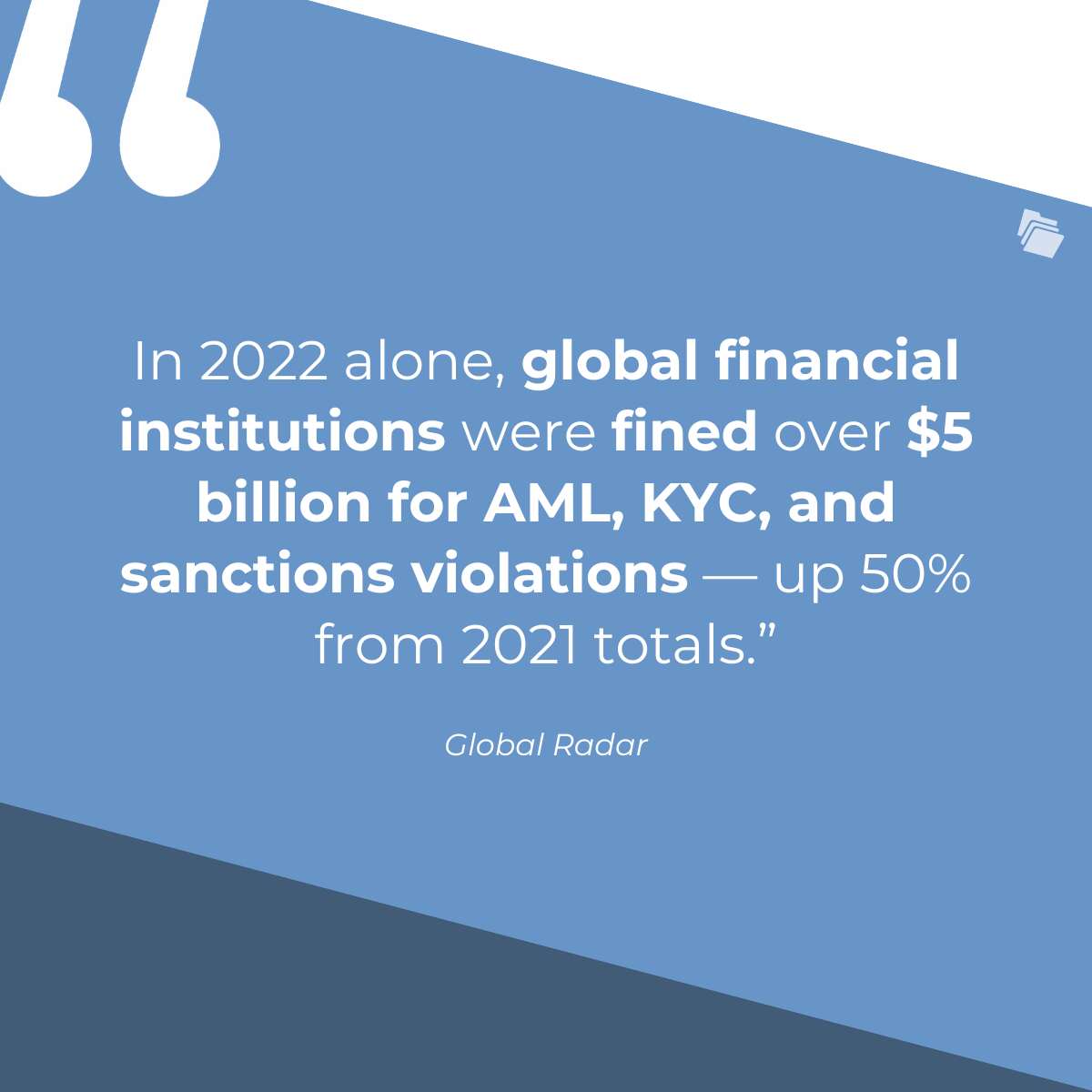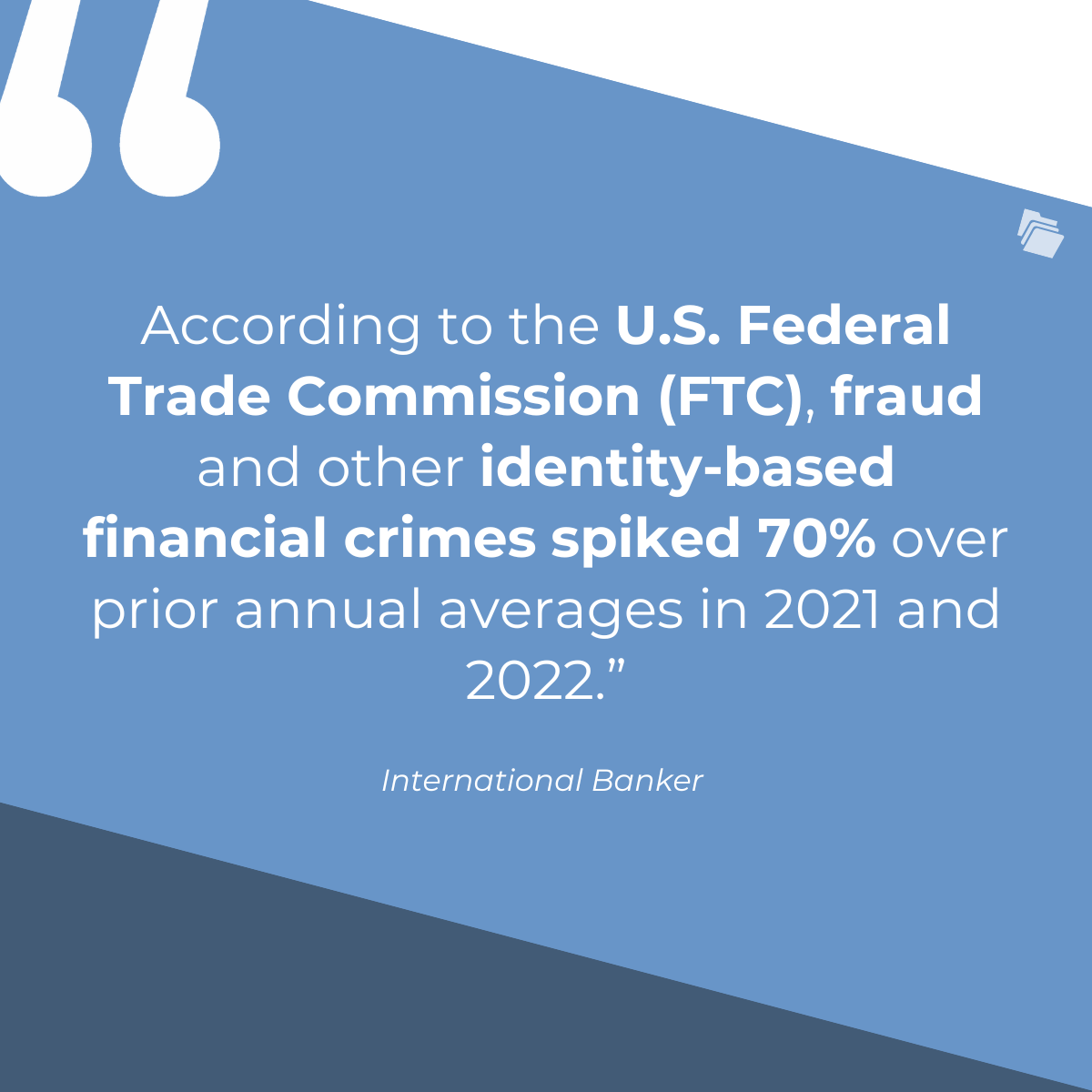What Are the 5 Types of Customer Due Diligence?
With CDD requirements becoming more complex, financial institutions must understand the different kinds of CDD processes. Here are 5 types of CDD...
Learn how AML and KYC bolster financial security and work together as a robust defense against the exploitation of financial systems.
In financial services, the acronyms AML and KYC represent two broadly standardized security protocols for preventing financial crimes and safeguarding the integrity of the financial system. Anti-Money Laundering (AML) and Know Your Customer (KYC) requirements are important processes banks and financial institutions perform to deter illegal activities such as money laundering, terrorism financing, and financial fraud.
AML requirements are designed to detect and prevent the process of making illegally obtained money appear legal, which enables many organized criminal activities and poses a severe threat to the financial sector's stability. On the other hand, KYC procedures target fraud and identity-based financial crimes. Both processes involve rigorous customer identification and due diligence to ensure banks do not extend financial services to criminal actors.
The interconnection between AML and KYC is significant. AML frameworks often rely on information and analyses provided by KYC measures. Together, they form a dynamic duo in the fight against financial crime.
This guide delves into the specifics of AML and KYC, examining their contributions to financial security and how they combine to create a robust barrier against the exploitation of financial systems.
Anti-Money Laundering (AML) regulations are a series of procedures, laws, and regulations designed to prevent criminals from making illegally obtained funds appear as legitimate income. These stringent measures are essential to safeguard financial institutions against the risks of financial crime and to maintain the integrity of the international financial system.
The primary objectives of AML are to detect and report suspicious activity that might signal money laundering activities. By doing so, AML helps disrupt the financial networks that support various criminal enterprises such as:
Furthermore, AML procedures aid in fostering trust in financial markets by ensuring they function efficiently and legitimately.
Money laundering has extensive repercussions for financial institutions, going beyond mere legal compliance. According to the United Nations Office on Drugs and Crime (UNODC), the amount of money laundered globally annually averages 2-5% of global GDP, or roughly $800 billion to $2 trillion U.S. dollars. These figures underscore the scale of the problem and the immense pressure on financial institutions to be vigilant and proactive.
According to the Financial Action Task Force (FATF), the international body setting AML standards, the failure to prevent money laundering can erode the stability and reputation of financial institutions, leading to legal consequences and significant financial losses. In 2022 alone, global financial institutions were fined over $5 billion for AML, KYC, and sanctions violations — up 50% from 2021 totals.

This threat takes various forms:
Financial institutions, therefore, invest significantly in AML programs, which include transaction monitoring systems, customer due diligence (CDD) processes, and compliance management strategies. As such, AML requirements have become a crucial business practice to protect themselves from being used as vehicles for, or victims of, financial crime.
KYC requirements exist to help banks and other financial institutions verify customer identities before contracting business relationships. During KYC processes, banks also create customer risk profiles and records of potential customers’ financial activities. This stringent identification protocol serves a dual purpose — protecting financial institutions against fraud, corruption, and money laundering, and maintaining a transparent, trustworthy banking system.
Around the globe many national governments and intergovernmental bodies like FATF mandate KYC measures for financial institutions. Although these regulations vary in detail, KYC processes typically include these imperatives:
Financial institutions demonstrate KYC compliance through meticulous record-keeping of customer identification procedures, risk assessments, and due diligence documentation. Institutions must maintain verifiable trails of customer interactions and transactions, ensuring all customer data is current and accurately reflects their financial profile.
Compliance audits, both internal and external, further validate the adequacy of KYC measures. These records are made available for regulatory reviews to prove adherence to established KYC requirements.
Identification and due diligence are critical to KYC effectiveness. Customer identification serves as the cornerstone of the KYC framework. It involves verifying personal data against multiple reliable, independent sources. This foundational step is pivotal in mitigating the risks of financial crime, as it prevents impersonation, fraud, and money laundering. Accurate identification is the first defense in ensuring that financial services are not misappropriated for illicit purposes, enabling institutions to maintain secure and transparent financial operations.
After verifying customers’ identities, banks must perform CDD requirements. To complete CDD, banks:
Several ongoing technological advancements are reshaping KYC procedures.
Collectively, these technological solutions significantly streamline KYC operations, reducing the risk of human error and increasing the efficiency and accuracy of CDD and ongoing monitoring.
AML and KYC act as complementary forces in the prevention of financial crime. AML programs, which encompass a broad range of regulatory processes, are designed to deter and detect the flow of illicit funds through monitoring, reporting, and sanctioning of suspicious transactions. Meanwhile, KYC forms the bedrock of these AML strategies, providing the essential customer data that informs subsequent monitoring efforts.
In practice, KYC mandates the collection of detailed customer identification data before establishing a business relationship, ensuring that financial services are not exploited for money laundering. This information then feeds into AML systems, enabling them to track and scrutinize customer transactions effectively against the backdrop of the customer's risk profile. Together, they work as a cohesive framework — KYC identifies who the customers are, while AML monitors what they do.
Financial institutions can integrate KYC and AML by establishing unified customer profiles that consolidate due diligence and transactional data, facilitating comprehensive risk assessments. They can also implement integrated software systems that enable seamless information sharing between KYC and AML monitoring teams, ensuring real-time updates and alerts.
Additionally, by adopting a holistic policy approach, institutions can align their AML controls with KYC procedures, thereby embedding compliance into every customer interaction and transaction, which ensures consistent application of regulatory standards and a unified defense against financial crime across all customer touchpoints and throughout the customer lifecycle.
Integrating AML and KYC is mutually beneficial and practical for several reasons. Coordinating these two initiatives:
Enhanced by technology, KYC processes now deploy sophisticated tools like biometric authentication, document verification algorithms, and AI-driven behavior analysis to achieve greater accuracy and efficiency. Consequently, technology's role in AML and KYC is growing, with 95% of AML executives prioritizing enhanced due diligence and compliance efforts that include tech-based solutions.
Many financial crimes have been on the rise since the rapid shift to remote work precipitated by the COVID-19 pandemic in 2020. According to the U.S. Federal Trade Commission (FTC), fraud and other identity-based financial crimes spiked 70% over prior annual averages in 2021 and 2022. For financial institutions, effectively combating this crimewave without compromising the quality of customer experience is often a matter of choosing the right technologies to expedite and harden processes like KYC.

At the forefront of such technologies for the financial sector is FileInvite. FileInvite is a secure file sharing and document collection platform with a full suite of cutting-edge features for streamlining identity verification and activity monitoring processes. The platform provides a sophisticated online digital KYC processing system, ensuring financial institutions can effortlessly meet regulatory requirements. Key features include:
The system represents a comprehensive solution that simplifies and secures the KYC process, making it a hassle-free experience for both the institution and its clients.
FileInvite enhances customer experience right from the start, cutting turnaround times on document collection processes by 80%. With features to ensure KYC and AML requirements process smoothly and minimal disruption to customers’ financial activities, FileInvite is the solution for emerging identity verification challenges in financial services.
To learn more and request a demo, visit FileInvite today.
With CDD requirements becoming more complex, financial institutions must understand the different kinds of CDD processes. Here are 5 types of CDD...
Looking to incorporate AI into your role? If you're in the financial services vertical, you might want to start with your KYC process.
As more financial institutions look at the “perpetual KYC” concept, they must also understand what the 'know your customer (KYC)' process truly means.
Eliminate the monotony of back-and-forth emails and inefficient systems when gathering client information. Get hours back each week as FileInvite handles the most time-consuming work for you.